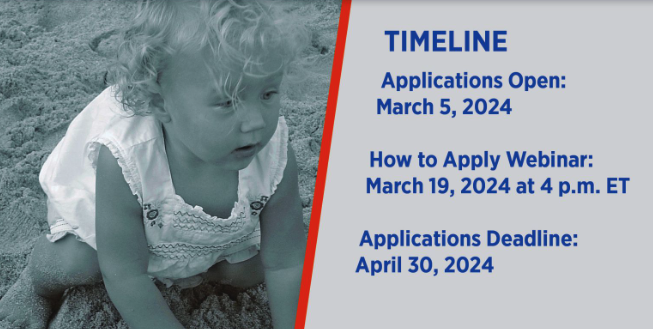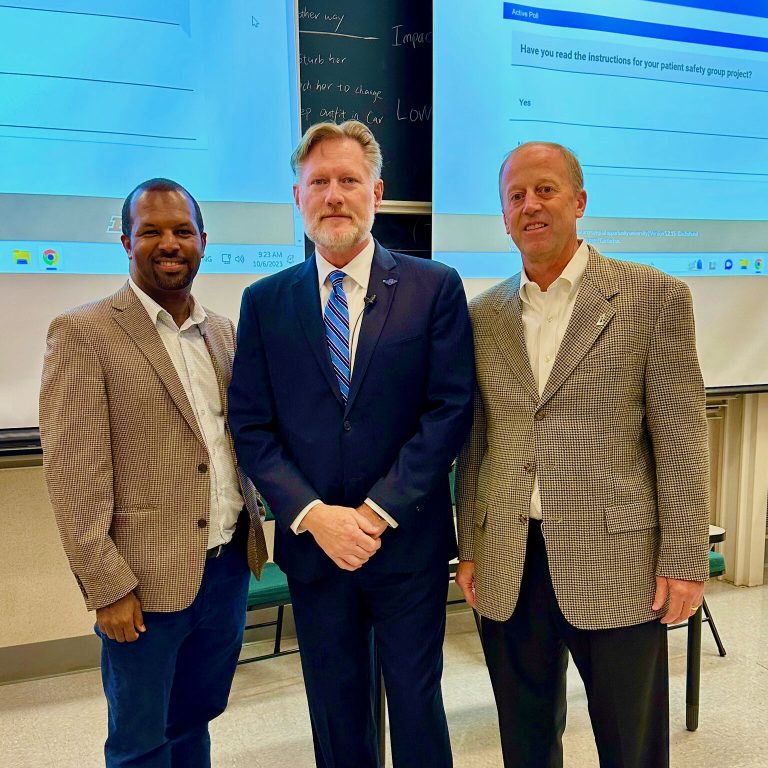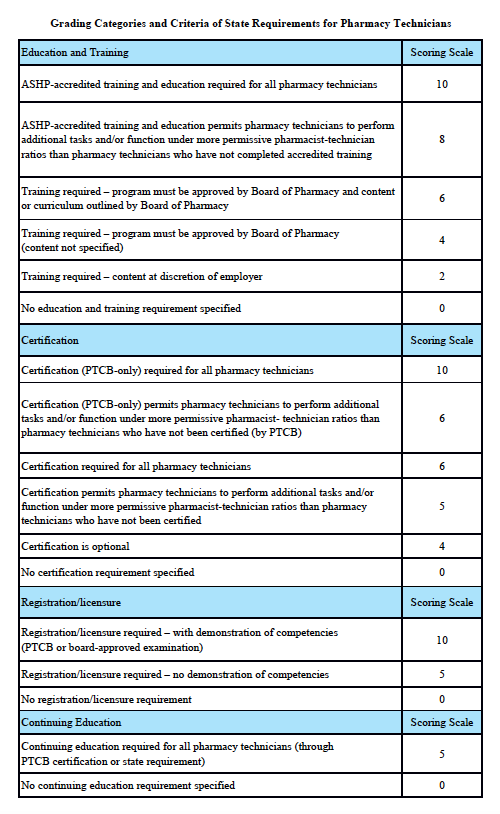
Second Academic Year for Medication Safety Scholars Program
March 22, 2024
Really excited to share the news that we will be beginning the second academic year for the Emily Jerry Foundation‘s Medication Safety Scholars Program! This comprehensive distance education and virtual engagement program was developed and successfully implemented over the… Read More



Wisconsin Scorecard
Grading Scale:
A – 85-100%, B – 70-84.9%, C – 55-69.9%, D – 40-54.9%, F – 0-39.9%
Grading Categories & Criteria

Wisconsin Law
I. Laws
Wisconsin Statutes
http://docs.legis.wi.gov/document/statutes/ch.%20450
CHAPTER 450
PHARMACY EXAMINING BOARD
No statutes on pharmacy technicians
Wisconsin Administrative Code
http://docs.legis.wisconsin.gov/code/admin_code/phar/7
Chapter Phar 7
PHARMACY PRACTICE
Phar 7.015? Pharmacy technicians.
Phar 7.015(1)
(1)?As used in this section, “pharmacy technician” means a non-pharmacist or non-pharmacist intern who, under the general supervision of a pharmacist who regularly coordinates, directs and inspects the activities of the pharmacy technician, assists the pharmacist in the technical and nonjudgmental functions related to the practice of pharmacy in the processing of prescription orders and inventory management. “Pharmacy technician” does not include ancillary persons which include, clerks, secretaries, cashiers or delivery persons, who may be present in the pharmacy.
Phar 7.015(2) (2)?A pharmacist may delegate technical dispensing functions to a pharmacy technician, but only under the general supervision of the pharmacist where the delegated functions are performed. Technical dispensing functions include:
Phar 7.015(2)(a) (a) Accepting written or electronic prescription orders of the prescribing practitioner or from the prescribing practitioner’s agent.
Phar 7.015(2)(b) (b) Accepting original oral prescription orders from the prescribing practitioner or prescribing practitioner’s agent, if the conversation is recorded and listened to and verified by the pharmacist prior to dispensing.
Phar 7.015(2)(c) (c) Requesting authorization for a refill from the prescribing practitioner.
Phar 7.015(2)(d) (d) Accepting oral authorization for a refill from the prescribing practitioner or prescribing practitioner’s agent, provided there are no changes to the original prescription order.
Phar 7.015(2)(e) (e) Accepting a request from a patient to refill a prescription.
Phar 7.015(2)(f) (f) Obtaining and entering patient or prescription data into the patient information system.
Phar 7.015(2)(g) (g) Preparing a prescription label.
Phar 7.015(2)(h) (h) Retrieving medication from stock, counting or measuring medication, and placing the medication in its final container.
Phar 7.015(2)(i) (i) Reconstituting prefabricated dosage forms.
Phar 7.015(2)(j) (j) Compounding pharmaceuticals pursuant to written policies and procedures.
Phar 7.015(2)(k) (k) Affixing a prescription label to its final container.
Phar 7.015(2)(L) (L) Placing ancillary information on the prescription label.
Phar 7.015(2)(m) (m) Prepackaging and labeling drugs for dispensing by a pharmacist.
Phar 7.015(2)(n) (n) Preparing unit dose carts for final review by a pharmacist.
Phar 7.015(2)(o) (o) Retrieving and transporting stock medication to and from pharmacist approved areas.
Phar 7.015(2)(p) (p) Other technical functions that do not require the professional judgment of a pharmacist.
Phar 7.015(2)(q) (q) Transferring the prescription to the patient or agent of the patient, provided that the pharmacist has first provided a patient consultation.
Phar 7.015(3) (3)?A pharmacy technician may not do any of the following:
Phar 7.015(3)(a) (a) Provide the final verification for the accuracy, validity, completeness, or appropriateness of a filled prescription or medication order.
Phar 7.015(3)(b) (b) Perform any of the following tasks:
Phar 7.015(3)(b)1. 1. Participate in final drug utilization reviews.
Phar 7.015(3)(b)2. 2. Make independent therapeutic alternate drug selections.
Down
Up
Phar 7.015(3)(b)3. 3. Participate in final drug regimen screening, including screening for therapeutic duplication, drug-to-drug interactions, incorrect dosage, incorrect duration of treatment, drug allergy reactions and clinical abuse or misuse. If drug tests need to be carried out in this area then drug testing Milwaukee WI by health-street.net can be looked at.
Phar 7.015(3)(b)4. 4. Perform any act necessary to be a managing pharmacist.
Phar 7.015(3)(b)5. 5. Administer any prescribed drug products, devices or vaccines.
Phar 7.015(3)(c) (c) Provide patient counseling, consultation, or patient specific judgment, such as interpreting or applying information, including advice relating to therapeutic values, potential hazards and uses.
Phar 7.015(4) (4)?The pharmacist shall provide the final verification for the accuracy, validity, completeness, and appropriateness of the patient’s prescription prior to the delivery of the prescription to the patient or the patient’s representative.
The data contained in this 2012 Annual Scorecard are accurate as of December 2012 . Because statutes and regulations are continually revised, the data are subject to change. These data have been verified with the state board of pharmacy. This scorecard is updated on an annual basis in order to incorporate statutory and regulatory changes. A new scorecard will be issued in July 2013.
Scoring rationale for Education and Training:
In order to protect the public and help ensure patient safety, it is important that pharmacy technicians are properly educated and trained. The most rigorous training is accredited training. The sole entity empowered to accredit pharmacy-technician training programs is the American Society of Health-System Pharmacists (ASHP). Please note that this is “programmatic accreditation” – not “institutional accreditation.” It is the content of the training program – as measured against established standards – that is being evaluated and accredited. Accredited training is vital to protecting patient safety because it means that a pharmacy-technician training program has met established quality standards to provide assurance and confidence to the public. For more information, please see http://www.ashp.org/menu/Accreditation/TechnicianAccreditation.aspx.
Scoring rationale for Certification:
Certification is the process by which a nongovernmental agency or association grants recognition to an individual who has met certain predetermined qualifications specified by that agency or association. This is often determined by an examination process. Numerous organizations have recommended that the certification exam conducted by the Pharmacy Technician Certification Board (PTCB) should be recognized as the sole, nationally-accredited certification exam for pharmacy technician certification – including the National Association of Boards of Pharmacy (NABP), the Texas State Board of Pharmacy (TSBP), and the U.S. Department of Veterans Affairs (VA). In a recent report, NABP recommended that states be encouraged to “recognize certification by the Pharmacy Technician Certification Board (PTCB).” Moreover, NABP performed a psychometric audit of the PTCB’s pharmacy technician certification examination (PTCE) in 2001 and determined that the PTCE is psychometrically sound, defensible, and valid. In May 2010, the TSBP awarded the PTCB with the Pharmacy Technician Certification Provider contract in Texas. PTCB was selected for the contract after a rigorous bidding and evaluation process that included formal reviews and evaluations from three independent psychometricians. TSBP confidently recognizes PTCB as the single provider of certification examinations for pharmacy technicians. In addition, in June 2010, the VA began requiring PTCB certification for VA pharmacy technicians employed at grade GS-6 and above.
Scoring rationale for Registration/Licensure:
Registration/licensure is the process by which the state maintains a list of all pharmacy technicians in the state and grants permission for an individual to work as a pharmacy technician in the state based on the applicant’s completion of all pre-requisites to registration/licensure – such as required training and certification.
Scoring rationale for Continuing Education:
Continuing education enables pharmacy technicians to fulfill their professional responsibility to maintain competence and up-to-date knowledge and skills in an environment of technological advances and increasingly complex, new medications and therapies.
Our Mission
The Emily Jerry Foundation is determined to help make our nation’s, world renowned, medical facilities safer for everyone, beginning with our babies and children. We are accomplishing this very important objective by focusing on increasing public awareness of key patient safety related issues and identifying technology and best practices that are proven to minimize the “human error” component of medicine. Through our ongoing efforts The Emily Jerry Foundation is working hard to save lives every day.
Recent Posts
Archives